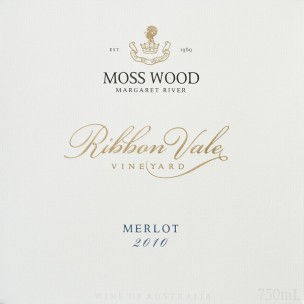Moss Wood Ribbon Vale Vineyard 2010 Merlot

Wine Facts
Blend: 96% Merlot and 4% Cabernet Franc.
| Harvested: | 23/3/2010 |
| Bottled: | 25/6/2012 |
| Released: | 3/9/2012 |
| Baume: | 12.70 |
| Alcohol: | 13.50% |
| Vintage Rating: | 10/10 |
SOLD OUT
Tasting Notes
Colour and condition: deep brick red hue; bright condition.
Nose: the aromas in this wine are a celebration of red and dark fruits but especially mulberry and black currant – remarkably generous. However, underneath are lots of interesting earthy and smoky notes, providing interesting nuances and complexity.
Palate: as with the Cabernet Sauvignon Merlot blend, it is another example of the success of the 2010 vintage. The mulberry and blackberry fruit flavours are mouth-filling, making the almost sweet and generous. However, Merlot’s characteristic tannins still arrive at the finish to give the wine a firm, bituminous finish.
Moss Wood Ribbon Vale 2022 Merlot – Erin Larkin, The Wine Advocate
The 2022 Ribbon Vale Merlot is from a warm, dry and early vintage; the confluence of these climatic conditions has come together as a superb red wine vintage in the region. Aromatically, the wine leads with redcurrant and pomegranate molasses, raw cocoa and tapenade. On the spice register, we see…
Vintage Notes
It might sound clichéd but the 2009/10 growing season was just about perfect. We had regular rainfall during Spring but missed out on conditions which may have compromised yields. At the same time, temperatures were warm enough to encourage even ripening but we received very little hot weather and so all varieties were spared any heat stress and the accompanying loss of flavour intensity.
This is not to say there weren’t occasions when we looked at the weather and wondered just what we might be in for. In particular, we had a very impressive thunderstorm during November that was, for a brief period, right over the Moss Wood vineyard and produced some spectacular lightning, the shock waves from which rattled the Mugford house windows. These events are often accompanied by hail and we held our breath while it went by. Fortunately, it didn’t dump on us but we feared a repeat of December 1996, when a similar storm reduced the crop by around 80%.Sometimes you get lucky! The other viticulutural threats of disease and bird damage were also kept under control, so we arrived at harvest feeling confident. As is usual, the vintage produced typical variation. Yields on the Cabernet Sauvignon, and Merlot were above average, 12% and 7% respectively but Cabernet Franc let the side down slightly being 7% below average. We suspect the above mentioned thunderstorm and the associated downpour right in the middle of the Cabernet Franc flowering period probably caused the latter problem. Harvest dates for Cabernet Sauvignon and Cabernet Franc were slightly early and their period from flowering to harvest were also shorter. On the other hand Merlot, which likes to be contrary, was later on both counts.
However, one aspect where the three varieties were consistent was ripeness where all were picked at slightly lower sugar levels than average. We think this gives an insight into the quality of the year, with the consistent but mild conditions allowing flavour, tannin and sugar ripeness to all proceeded in unison. A further note regarding quality is the impact of higher yield for the Cabernet Sauvignon. It is an interesting fact that the Moss Wood wines of which we are most proud all come from these sorts of vintages ’08, ’05 and ’01 to name just a few. Yet it is frequently assumed that lower yield will produce better quality. Pinot Noir is often used as an example and yes, it seems to benefit from a commensurate increase in concentration. However, Cabernet’s greater depth of colour and tannin mean lower crop levels can increase concentration to the point where the wine is dense, unyielding and very slow to mature.
Our best experience of this is the 1981 Moss Wood Cabernet Sauvignon, a very small-cropped year which took two decades to exhibit any maturity, roughly half the normal rate of development. The wine has extraordinary cellaring capability but we’re not convinced this is a great thing, other than to perhaps establish bragging rights. Take as an example the 1980 vintage - that Cabernet Sauvignon has now successfully cellared for 30 years and where the cork is sound, shows no sign of deteriorating. This being the case, it begs the question is there anything to be gained by keeping a low yielding year for say 50 years?
Production Notes
Median Harvest Dates:
Cabernet Sauvignon – 27th March, 2010
Merlot – 23rd March, 2010
Cabernet Franc – 5th March, 2010
Harvest Ripeness:
Cabernet Sauvignon – 13.4⁰Baume
Merlot – 12.7⁰ Baume
Cabernet Franc – 12.8⁰ Baume
All the fruit was hand-picked and destemmed into small, open, stainless steel fermenters. Each batch was inoculated with pure yeast culture and fermentation temperatures were maintained at a maximum of 28°C. Extraction of colour and flavour was by hand plunging up to four times per day. The impact of tannin was monitored with daily tastings and the individual batches were pressed when optimum balance had been achieved. For the Cabernet Sauvignon this was 23 days, for Merlot 17 days and for Cabernet Franc, 10 days. After pressing, each wine was racked into barrel where malolactic fermentation took place. Upon completion the wines were racked backed to stainless steel tanks, adjusted for acidity then returned to barrel.
In February 2011 tasting trials were used to decide on the best blends for 2010. The quality of the Cabernet Sauvignon stood out and its contribution rose quite significantly compared with the ’09. The final blend was 75% Cabernet Sauvignon, 18% Merlot and 7% Cabernet Franc. The Merlot on the other hand held to tradition, or close to it, with 96% Merlot and 4% Cabernet Franc. The new blends were racked back to barrel, where they stayed until June 2012, for a total of 26 months in wood.
Both wines were racked to stainless steel and fined, the Cabernet Sauvignon Merlot with egg whites and the Merlot with skim milk, and then sterile filtered and bottled on 25th June, 2012.
Cellaring Notes
The issue of cellaring for our Merlot wines is curious. With such early generosity and complexity, the wine is unquestionably enjoyable to drink as a youngster and this begs the question of what benefit may be achieved by aging. The answer is that for consumers who prefer the plentiful fruit flavours, the wine is at its best when young. However, for those who enjoy the complexity that comes with time in bottle, it has a long and promising life in front of it. We suggest a minimum cellaring time of 10 years but recommend 15 to 20 years to allow the wine to reach full maturity.

